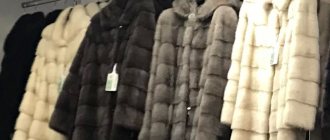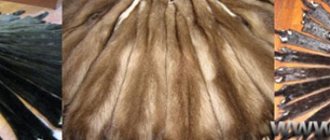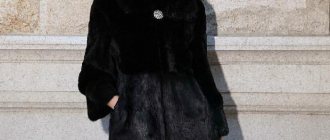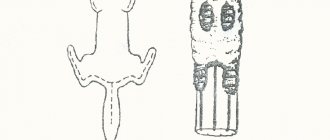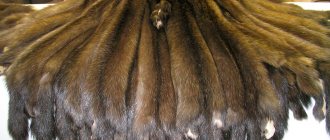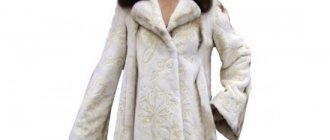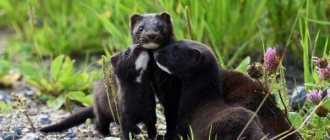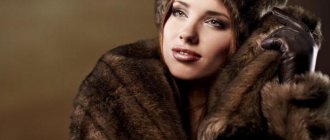Basic rules for purchasing high quality fur products
When planning to purchase a fur coat made of natural fur, you should go to a store that has proven itself well and provides the appropriate certificates and guarantees. In pursuit of savings, you should not look for options in the market. You can find fakes there most often, but then it will be difficult to find the ends.
Now we’ll tell you how to distinguish a high-quality mink coat.
- Mink fur is elastic. Run your hand along the pile in the opposite direction. It should return to its original position. Despite its elasticity and rigidity, the fur does not prick.
- Smooth undercoat, awns of the same length. To disguise a fake, sellers often cut the guard hair so that the length is the same. But in this case, the fur will prick.
- There should be no hair left on the hand when pinched.
- Mink skin has a shine. Single white hairs are sometimes visible on undyed pile.
- Run a white cloth over the fur. There should be no traces of paint left on it.
- The height of the pile on the entire product should be the same. There should be no bald spots, bald spots, or bumps.
- Good manufacturers do not hem the lining, giving the opportunity to inspect the quality of the flesh. It should be light or creamy, elastic.
- When shaking, the fur coat should not rattle.
- Check for stamps on each skin. She confirms that this is mink and indicates the size of the piece (at least 15*15 cm).
- Look carefully at the seams. They should be thin, rolled out and even. Skin is sometimes sewn between fragments of skins. The fewer such areas, the more expensive the product. If you notice the glue, it is better to refuse the purchase. The technology in which the skins are glued together rather than stitched will not allow the product to last for a long time.
Natural fur. Fox
Fox fur is a long-haired type of fur. It is often used for finishing products and sewing hats. Now fox vests have come into fashion. Products made from fox are very warm and beautiful. The following types of fox fur can be found on sale: gray fox; red; cross; red fox, silver fox, arctic fox. The corsac (steppe fox) is smaller than the common fox (less than 55cm), the corsac's hair is shorter and less luxuriant. The corsac dog is often confused with the fox, which is found in abundance in the Volga region. But its fur is noticeably shorter and does not have such a bright red hue as fox fur. Fox fur warms well in severe frosts, but in rainy weather the luxurious long pile hangs in icicles and loses its attractiveness. When purchasing, keep in mind that dyed fur is more expensive, but wears worse.
Manufacturer country
Depending on the country in which they are produced, mink coats have several types. Canadian and Scandinavian minks are considered one of the most expensive. They are distinguished by abundant fluff and very thick pile of medium length. The Ukrainian mink is slightly inferior to them. Its underfur is not so thick, and its awn is longer.
Greek fur coats are very popular among Russian women. There is also an opinion that the cost of fur coats is lower in Greece. Some even go on special tours to buy furs. But in any country there are both high-level and less conscientious manufacturers. A high-quality mink fur product will not be cheap. Therefore, it is better not to take risks by making expensive purchases in resort areas.
Russian and Chinese mink coats are much cheaper. Currently, some Chinese manufacturers have also learned to make good quality fur products. But there are also plenty of fakes among them. Therefore, it would be a shame to buy a Chinese fur coat at the price of a Canadian or Greek one. Here are a few signs by which you can distinguish a Chinese fur coat from a European one:
- Ost. Pronounced and very high. Outwardly it seems prickly. It's like she's lying on the pillow. But sometimes the spine does not differ in height. In this case, the skin can be passed off as Scandinavian.
- Shine. Chinese skins do not have a smooth sheen; they seem to shine in areas. They can be recognized by their characteristic glassy sheen. If you compare Chinese and Scandinavian fur coats, even a non-specialist will immediately notice the difference. Scandinavian furs are distinguished by a beautiful diamond shine that seems to shimmer in the sun.
- Undercoat. Depends on the length of the spine. With a long guard, the undercoat is not dense. Sometimes a mink with short hair and long black fur is passed off as a black mink. But natural black mink has a light core, which after dyeing takes on a dark or gray tint.
Based on these indicators, you can understand where the animal was raised. The place where the fur coat was produced is determined by the sewing technology. In most cases, Greek and Italian fur coats are made from Finnish and Scandinavian skins. Russian mink differs from Chinese mink in having thick and long pile, while Scandinavian mink has thick but short pile.
Sometimes the Chinese use Greek furs for tailoring. In this case, quality should be determined by sewing technology.
The most valuable and expensive fur is sable fur.
Sable fur is the most valuable and expensive type of fur. The price of a pair of sable skins can be equal to the price of a mink sheepskin coat. Due to the high price, most often, sable is used only for finishing products, such as collars, hoods, cuffs, etc. Long-skirted sable coats can only be seen on the catwalks of fur auctions. Any fur must “breathe,” especially sable. You can’t leave such fur in the closet for too long. Even in summer, you need to ventilate your fur product sometimes. When purchasing products made from sable fur, you must make sure of its quality. A low price may be a sign of poor fur production.
Mink fakes
The first sign you need to pay attention to is weight. A mink coat is much lighter than any other fur. Often, the manufacturer skillfully disguises a rabbit, marmot, beaver or ferret under an expensive skin. Therefore, you need to know how to distinguish a real mink coat from a fake.
- Rabbit. Unlike mink, rabbit fur is very soft and has a non-uniform shade. The mink skin shines evenly. Rabbits have different hair colors. The rabbit's undercoat leaves hair in the hand when pinched.
- Marmot. The groundhog is often passed off as a mink. Their difference is that the marmot has prickly fur and hairs of different lengths. Marmot hair is also elastic, but does not have plasticity and can become shaggy when stroked. Mink fur, unlike marmot fur, does not give off a bluish tint in the sun.
- Beaver. Beaver and marmot fur can be confused with each other in terms of their stiffness. But both of them are much tougher than mink. Beaver skins are larger in size than mink. The beaver's flesh is twice as thick as mink.
- Ferret. The ferret, compared to the mink, has a higher spine and sparse underfur. It has a peculiar color: the underfur is light, and the awn is dark at the ends. On the sides, light areas are visible, and on the back, a dark-colored spine completely covers the underfur. By the way, ferret skins are not valued much less than mink. They are less wearable, but warmer. Products are not sewn from ferret skins “unraveled”, because the seams will be visible through the fur due to the sparse fluff. Therefore, models made from this fur are mostly straight cut.
- Honorik. This animal is the result of crossing a mink and a ferret. It is quite difficult to distinguish this fur from real mink. It is distinguished by its black color, shine and thick brown undercoat.
Marten fur
Marten fur is very similar to sable fur. Often, marten fur is even used to sew fur coats. The color of the marten's fur is very similar to the color of the sable's fur, but the marten's hair is not so soft and lush, not so delicate and silky. The size of the marten skin reaches 40-50 cm in length. If you dream of buying a sable fur coat, but you don’t have enough money, then a marten fur coat will help you make this dream come true. The main thing is to answer everyone who asks that this is a fur coat made of sable, because marten fur is so similar in appearance to sable fur.
Natural fur. Nutria
Nutria skins are used mainly for sewing fur coats and other outerwear for women. The skins of plucked nutria are similar to mink. There are many colored rocks: smoky, cream, straw, white, beige, pearlescent, silver, golden, black. The best quality of hair is medium height with elastic hair that completely covers the ridge and sides. Nutria is very often produced in artisanal conditions. Beware of shopping for "homemade" skins. The dressing process is very often carried out according to the “folk method” and the skin turns out to be loose and short-lived.
Elegant Scandinavian mink
The most popular and widespread on the world market. Its fur has a thick, padded underfur, as well as even, medium-length guard hairs, which is why the products look very beautiful. Moreover, fur coats retain heat well and are quite light. Due to the peculiarity of the fur of the Scandinavian animal, they have good wear resistance, and, as a rule, can decorate a winter look for 5-7 seasons. Natural shades are most valued because they have a natural, healthy shine that does not fade over time. In undyed fur, the underfur is usually half a shade lighter than the guard hair, so color tints form on the product. Women's models of fur coats in the color “black diamond” are especially popular. Fashionistas simply adore them for their special luxury.
Models made of luxurious fur come in a wide variety of shades - brown (from sable to cognac), dark chocolate, extravagant black cross, elegant black, elegant pearl, gray-blue. The choice of a fur coat among such a variety can be made even according to the color of your eyes!
How to correctly determine the color quality of a mink coat
Whether the fur coat is dyed or not, you should have understood at the stage of assessing the quality of the fur. Let us remind you: if the outer side of the skin differs from the inner, then the fur could be dyed with a special tinting agent .
But sometimes craftsmen manage to give the pile a more noble shade without touching the core. In this case, the undercoat will help to correctly identify the fake: carefully pull out a couple of hairs and examine them in the light. If the pile has the same shade along its entire length, this is indeed a natural mink. And if the color at the base is darker or lighter, then they are trying to fool you with all their might.
In general, dyed fur is not a death sentence. If the entire technological process is followed, tinted fur can serve well for five or more seasons without losing its properties and visual appeal. To understand how high-quality the tonnage was used, soak a white handkerchief in lukewarm water and wipe the lint and core. If after such a procedure the fabric remains as clean as before it began, you can safely buy a fur coat - even after rain, the paint will not stain the clothes.
To avoid becoming the “lucky” owner of a non-existent pure black mink, remember that the natural color of fur varies from reddish-brown to dark brown. Any other shades (except for elite white or charcoal brown mink) indicate the use of tonnage or dyes.
Both dyed and natural mink should be the same tone (sometimes a darker undercoat is allowed) and have a beautiful shine.
Interesting classification features
The commodity classification of mink fur is different:
- products from animals raised in the wild are divided into 3 varieties;
- by the number of defects - for furs with minimal, medium and large flaws;
- the furs of free animals are distinguished by habitat;
- raw materials from caged minks are classified into 2 grades;
- All mink furs are divided by color and size.
First grade furs are called full-haired. They have a shiny coat with dense spinous hairs and down. The inside (underside) is clean, homogeneous. A slight blue tint may be visible along the edges of the fur at a distance not exceeding 3 cm.
Specimens of the second grade have less full-haired fur. It shines. The awns and down are not fully developed. The tail may not be too furry. The blueness on the flesh is larger than in first-class furs.
Third grade mink fur is obtained only from free animals. They have smooth, shiny, thick semi-hairy fur with a blue underside. The hairiness of the tail leaves much to be desired.
The differences in defect evaluation are interesting. Thus, if in a caged mink small fur defects include breaks that reach 15% of the total area, then for fur of this category obtained from free animals, the size of the gap can reach 25%.
Important! Skins from spring animals with thinning hairs, thinning awns, and yellowish flesh are valued at no more than 25% of the cost of first-class fur with large sizes. Skins of animals that lived in the wild, obtained in the off-season, should not be used for work at all.
How to correctly assess the quality of the flesh of a mink coat
The quality of a fur coat is measured not only by the quality of the fur, but also by the quality of the fur - the skin to which the pile is attached. We recommend checking the flesh following the following rules:
1. A conscientious manufacturer does not cover the inner part with a lining , or always leaves an unsewn edge so that a knowledgeable buyer can evaluate the quality of workmanship and tailoring, feel the inner part, and examine its color and texture.
2. Assessment of the structure of the inner layer . You should start with smell, shade and density. High-quality mink skin should have a uniform structure without cracks and growths, be as soft and elastic as possible, not overdried, but not greasy. If it is too dry, it will not be able to survive severe frosts, it will begin to creak and crumble, and if it is greasy, it will stain clothes and emit an unpleasant odor. Try to find a fur coat, the finishing of which is as close as possible to the golden mean - it can even last for several decades.
3. Assessing the size of the skins . The method of sewing a fur coat also matters a lot, which can be determined only by looking at the inside. High-quality fur coats are made from whole mink skins with an area of no more than 25 cm2. Cheaper products use substandard fur and skin trimmings, so they must be cut and dyed to even out the shade of the pile.
4. Assessing the color of the flesh . Ideally, you should see a natural light beige, milky, slightly grayish tint. If there is a dark gray or yellow skin hidden under the pile, you are looking at a fur coat from “old stock” that is unlikely to survive more than one or two seasons. Also, a dark, earthy color may appear due to improper preservation of fur for the summer, which leads to hair loss in winter.
Make sure that the color of the fur is the same on both the outside and the inside if you are buying a fur coat made from undyed mink. If a tinted model has sunk into your soul, the tones of the pile and the skin on the outside must match, but the inside must be light. Often, cheap products are dyed using the complete immersion method, which negatively affects the properties of mink and can impair performance characteristics, so it is best to avoid such models.
5. Assessing the quality of fur coat tailoring . Upon careful inspection, you can find small punctures along the seams on the back of the fur coat - they are acceptable and indicate that the skins have been properly dressed. During the sewing process, the edges of the mesh are moistened and stretched, connecting them together with special thinnest nails with a diameter of up to 0.3 mm. At the end of all the necessary procedures, these “clips” are removed - and almost invisible punctures remain near the seams.
But if you notice holes in the center of the skin, the fur coat was most likely handmade or stored in improper conditions. Also, refuse to purchase if the size of the holes near the seams is more than 0.1-0.3 mm - during wear, the skins will tighten, which will lead to a decrease in size.
The seams should not stand out against the general background. If they are noticeable from the outside or palpable when worn, this will not only create discomfort, but will also affect the lifespan of the fur coat.
The risk area is the shoulder seams of inexpensive fur coats with a hood. Most often, this is where all the defects are hidden, so be sure to check the quality of the connection between the skins. The stitching should be even and there should be no fur caught between the mesh and the thread.
Natural fur. Raccoon
Raccoon is a currently popular type of fur imported from North America. American raccoon fur is quite warm and has a beautiful appearance. The hair of the skin is harsh, dark brown or yellowish-brown with brownish down. A very beautiful tail with transverse black-brown stripes, wonderfully decorating soft fur hats. Often, striped raccoon skins are enhanced by lightening individual guard hairs in order to imitate a silver-black fox. The raccoon dog differs from raccoon skins by its striped tail and “mask” on its face. The raccoon dog's fur is a little coarser. Raccoon fur is very warm, the hair is very thick, the fluff resembles the fluff of a goat. The hairline is longer than that of the Arctic fox.
Otter fur
Otter is considered the most wearable fur and is used as a standard to compare other types of fur. Since it is an aquatic fur-bearing animal, otter fur is very resistant to moisture and precipitation. Otter skins vary in color. From dark chestnut to light brown. The height of the hair is up to 3 cm, the height of down is up to 2 cm. The down is very soft, silky, durable. The length of the skins can reach 1 meter. Thick leather fabric. It is considered “men’s fur”; only plucked skins are used for women’s products. Products made from otter can save you a significant amount, and they will look no worse than “rich” furs. Modern technologies can do “miracles” with any type of fur.
